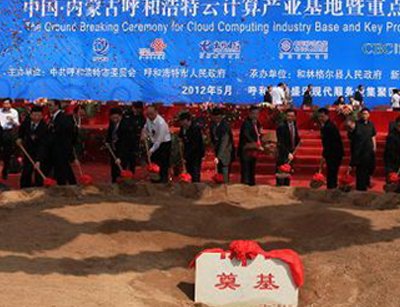On May 10 this year, the Hohhot Cloud Computing Base of Inner Mongolia broke ground.
The new Hohhot Cloud Computing Base - built with an investment of 50bn CNY - is made up of six large projects, including China Telecom’s Inner Mongolia Information Park, China Mobile’s Hohhot Data Center and China Unicom’s Northwest (Hohhot) Data Center, coupled with power supply and cloud computing equipment manufacturing projects.
According to news site Xinhuanet, the telcos alone have invested 40bn CNY into their operations at 25 sq km cloud computing hub already.
China Telecom plans to invest 12bn CNY for building the Inner Mongolia Information Park, which will consist of cloud computing centers, internet data centers, call centers, warehouses, office buildings and living areas. The park will provide cloud computing services, storage and network services once complete.
China Telecom’s investment was also focused on high-speed service delivery. It has launched a number of high capacity bandwidth projects, including the Beijing to Hohhot optical fiber transmission project, Beijing to Yinchuan to Lanzhou optical fiber transmission project and the China to Russia International optical cable transmission project alongside its large Hohhot data center investment.
China Mobile’s Hohhot data center project also has a cloud edge. Its facility will be built in three phases – the first two with 720,000sq m of data center space at a cost of 12bn CNY.
A modular design will ensure it can expand in future, and free cooling combined with other advanced cooling technologies will ensure the massive data center remains efficient. Once complete, the data center will provide concentrated network management, enterprise services and promote research and development innovations for new technologies including TD-LTE (Time Division Long Term Evolution – 4G networking), cloud computing and the internet of things.
China Unicom has committed a similar investment to the park so far – with 12.3bn CNY committed for a three-phase data center facility.
“China Unicom’s Northwest (Hohhot) data center will be built as a very large project that integrates the functions of cloud computing data centers, call centers and internet data centers”, Zhang Jun’an, deputy general manager of China Unicom said.
The project will not be complete for another ten years but once it is finished, China Unicom said it hopes it will become the most environment-friendly, most efficient and the most advanced data center in China.
From a private company perspective, CBC Capital has also committed 8.15bn CNY for building a Cloud Computing Entrepreneur Park which will be used to provide cloud-based data storage and services and as an equipment manufacturing base, and as a center for cloud training.
Power suppliers are also taking a keen interest in the Hohhot Cloud Computing Base. Beijing Energy Investment Holding said it will build a 2×350 MW and 2×600 MW cogeneration plant with 8.5bn CNY. While Inner Mongolia Electric Power Co said it will invest 1.11bn CNY for building one 500kV substation and two 220kV substations.
Why is Hohhot so hot?
Why has Hohhot become one of the most favored destinations for cloud computing investment in China? The area has a number of advantages for cloud providers including abundant power supply, favorable climatic conditions, availability of skilled staff and preferential policies.
Hohhot is rich in hydroelectric and thermal power resources. It is said that the water resource of Hohhot reaches 1.2bn m3 with average yearly rainfall of 410mm. Moreover, Hohhot is the largest thermal power generation base in Asia. At present, it is able to provide a power capacity of 7.7m kW, with to-be-completed thermal power capacity totaling 1.8m kW. Such abundant, reliable yet cheap power supply is quite attractive to IT companies -data center players in particular.
Hohhot’s average altitude is 1050 meters, and its average annual temperature is around 6.5Ôäâ, which means data centers can make use of free air cooling for up to eight months a year.
The region is also home to 70% of the key universities and research institutions of Inner Mongolia, and has long-established ties with a number of renowned domestic universities and research institutions, including the Chinese Academy of Sciences, Tsinghua University and Huazhong University of Science and Technology.
Last but not least, Hohhot, as a place where West Development Strategy is implemented, offers preferential policies to cloud computing players. A case in point is the announcement of Instructions on Promoting Rapid and Stable Development of Inner Magnolia by the State Council in June 2011, which encourages the development of cloud computing industry of Hohhot by offering a series of favorable conditions and terms to investors.

